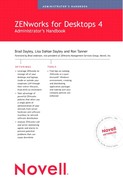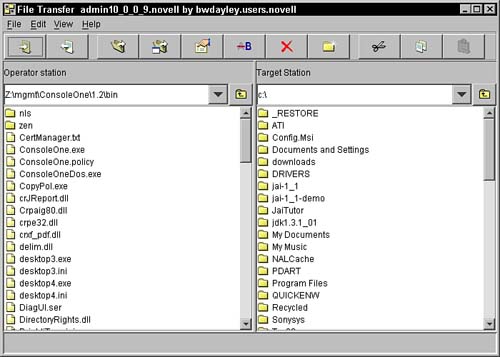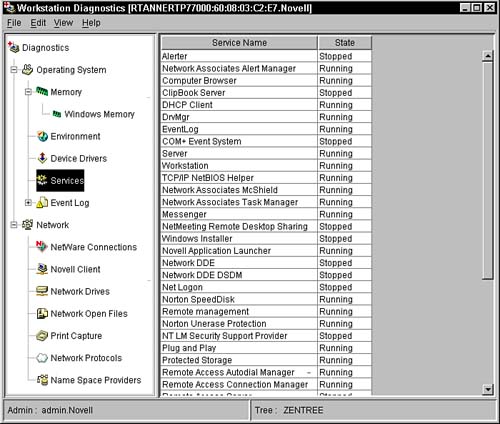Once the ZENworks for Desktops 4 system has been deployed across the network, the workstations have the ZENworks for Desktops agent, and the workstation is registered, you can maintain and manage the workstation from any location in the network. This provides obvious benefits, because support technicians rarely have to visit the individual workstation. This is a significant cost improvement over previous methods.
To maintain any particular workstation, you need to right-click the workstation object in ConsoleOne and select Properties, and then on the tabs you can get to a list of maintenance actions that can be performed on that workstation. The following sections discuss the actions you can perform.
An extremely useful action you can perform on workstations you are managing is checking the inventory for the particular workstation you are working on. The inventory provides you with useful information about the hardware and software installed on the workstation.
Accessing the workstation's inventory enables you to determine whether there are any obvious hardware or software problems or incompatibilities in the system. For instance, you could determine that the workstation is running an outdated version of software that needed to be upgraded. You could then upgrade the application using ZENworks application distribution.
The following list details the specific information you can get from the Inventory list:
• General—General information gives you the basic information about the workstation such as the name, user, serial number, and so on. It also gives you login information.
• Software—Software information includes everything about the software installed on the workstation from the operating system to the specific drivers being used. The software option includes:
• Software Vendors—Lists the vendors of the software installed on the workstation. By clicking on a vendor, you can see a list of applications by that vendor and determine which version of the application is installed.
• Device Drivers—Lists drivers installed for each device on the system.
• Operating Systems—Lists the operating system or systems installed on the workstation.
• NetWare Client—Shows the version of the NetWare Client.
• Inventory Scanner Information—Displays the version and mode of the inventory scanner that's running on the workstation.
• Hardware—Lists all the hardware installed on the workstation. This includes everything from hard drives to port information. By clicking a listed hardware component, you can get detailed information about that component, thus allowing you to assess the hardware needs of the workstation.
• Network—Gives you the DNS name of the workstation.
• System—Includes general information about the basic system components such as the motherboard and CPU.
On some occasions, it is necessary to remote control a workstation from any other workstation in the tree. You can remote control a workstation via the IP or IPX protocol and from any workstation in the network; however, you must have Novell Directory Services rights to control the workstation. Before you can remote control a workstation, you must complete the following:
-
The proper remote control agents must be present on the workstation. This can be accomplished by installing the ZENworks for Desktops 4 agent that ships with the product.
Additionally, you can deliver the agents to the workstation via the ZENworks for Desktops 4 Application Launcher. When ZENworks for Desktops 4 is installed into the tree, several application objects are created for the remote control agents for the Windows NT/2000/XP and Windows 98. If you have the Application Launcher launched from the login scripts of your user, you can force-run the deployment of these agents to ensure that all workstations have the proper agent.
-
The workstation must have registered with Novell Directory Services and have a workstation object imported and associated with the Workstation Policy Package if you want to use eDirectory rights to control who can remote control a workstation or a user. Alternatively, with ZENworks for Desktops 4 you can remote control this process using a password and IP address. This is launched from the Tools menu of ConsoleOne. The password you enter must be the same password that the user entered into the remote control agent.
A good way to test that you have got a good association is to modify some of the policies associated with the workstation and determine whether the changes take effect. One thing to do is to change the remote control policy so that the icon shows on the taskbar or the desktop and then determine whether this takes effect on the workstation. By doing this, you know that the workstation is associated with the object and that the system is communicating properly with Novell Directory Services.
-
You must have rights to perform the remote control. When the remote control session starts, the session manager (program that runs from ConsoleOne) determines whether you have rights to remote control the workstation. Additionally, the agent also verifies that you have rights to control the workstation.
The rights to remote control a workstation can be given in several ways. One way is through the ZENworks Manage Remote Operators wizard launched from the Tools, Management Remote Operator in ConsoleOne. This wizard walks the tree starting at the specified container and makes sure that the users specified gain rights to remote control the workstations. Additionally, you can go to the workstation object itself and add users to the Remote Operators page. When they are added to this page, they are given rights to remote control this workstation.
Once the system is set up with the workstation, you can remote control any registered workstation that you have rights to remote control. To remote control a workstation, you need to do the following:
-
Start ConsoleOne.
-
Browse in the tree to the particular workstation object for the workstation that you want to remote control. Highlight the workstation object. You can start remote controlling the workstation by right-clicking and selecting Actions, Remote Control on the workstation object menu, or you can view the details of the workstation and launch remote control from the Remote Management page, Remote Operations button.
-
The remote control session manager verifies that you have rights and then attempts to connect to the remote control agents on the workstation associated with the object. The agent then responds and begins the remote controlling of the workstation, and you are presented with a window on your machine that represents the desktop of the remote machine. You now have control of the remote workstation until you exit the remote control session.
You can configure the remote control from the remote control policy of the Workstation Policy Package discussed in Chapter 9, “Setting Up a Workstation Policy Package.”
The remote view enables you to monitor a workstation the same way that remote control enables you to remote control a workstation. By using the remote view option, you can observe everything that is being done on a specific workstation. You cannot affect the workstation like you can with the remote control option. This view helps you determine user errors that might be causing problems. The remote view uses fewer system resources than remote control on both the managed workstation and the management console.
You can configure the remote view from the remote control policy of the Workstation Policy Package discussed in Chapter 9.
The file transfer option enables you to copy, delete, or move files to and from any particular workstation. This can be useful when you need to get a new driver to a user or free up space by deleting extraneous files from a workstation. The file transfer window, shown in Figure 15.1, displays the local file system on the management console workstation in one pane and the remote file system on the managed workstation in another.
Remote execute enables you to run an application or perform a command on a workstation. Selecting this option pops up a window that prompts you to specify a command to be executed. For instance, if two users have conflicting IP addresses, bound on their workstations, you can execute the following command on one of the workstations to resolve the conflict:
IPCONFIG /release
You can configure the remote view from the remote control policy of the Workstation Policy Package discussed in Chapter 9.
There are occasions when it is beneficial to perform some immediate diagnostics on a particular workstation. From the ConsoleOne utility, you can perform immediate diagnostics on the workstation. These diagnostics perform an immediate connection to the agent on the workstation and then deliver to the administrator information about the workstation. Figure 15.2 shows the output screen from the diagnostics.
The diagnostics information includes the amount of memory available and used, the environment information, device drivers, services information, and the event logs. In addition it displays the network connections, drives, and open files. Also it shows client information, printers, network protocols, and name space providers.
This tool provides you with some real-time information about the workstation as you debug the system and repair your user's problems.
Remote wakeup enables you to remotely boot up a system that is powered down. In order to do so, the system must have a network card that supports Wake-on-LAN. The Wake-on-LAN agent must be installed on the managed workstation. The Remote Wakeup feature enables you to manage workstations during off hours, thus minimizing the user downtime during working hours.
The Remote Management Audit option enables you to store information about the remote management sessions running on the managed workstations as log files. This feature runs automatically when any remote management session is initiated with a workstation. These audit files are stored in the AUDITLOG.TXT file, which is created and updated when there are no remote management sessions in progress. The information that can be found in these files includes the following:
• Start Time—Start time of the event occurrence.
• Duration—Duration of the remote management session.
• Console DN—Name of the management workstation.
• Console User DN—Name of the remote operator.
• Operation Code—The various operations that a management console user can perform on the managed workstation. These codes are as follows:
Remote Control = 1
Remote View = 2
File Transfer = 3
Remote Execute = 5
Remote Diagnostics = 6
• Operation Status—The status of the event indicates whether the particular event was a success or failure. 1 indicates that the remote management operation was successful and 0 indicates that the remote management operation was unsuccessful.
An example of an audit record is as follows:
1005572546000 1000 workstation1 admin.novell 1 0
The AUDITLOG.TXT file will store up to 100 of these records in the system directory. You can store more records than this in a centralized database by installing the workstation inventory agent on every managed workstation. The inventory scanner will then collect the records and store them as scanned data files in the scan directory on the inventory server. You can then configure the number of audit records that can be stored for each workstation on the RM Audit tab of the Inventory Database Object.
Another extremely useful tool when managing workstations is the capability to generate a remote management report. This report shows you the number of times a particular workstation was remotely managed as well as errors managing remote workstations. This can help you troubleshoot management issues.
You can run a configured remote management report from the inventory database. Use the following steps to generate the remote management report:
-
Click on a Server object in ConsoleOne.
-
Click Tools, ZENworks Reports.
-
From the Available Reports list, double-click RM Audit Reports. Click Remote Management Report.
-
Specify the selection criteria for: Date of Operation, Console DN, Console User DN, Target Workstation DN, Operation, and Operation Status.
-
Click Run Selected Report. A status box appears displaying the progress of the report generation. When the report is generated, it appears in the viewer. Use the buttons on the toolbar to page through, print, or export the report.
There might be occasions when you need to unregister and re-register a workstation with eDirectory. When the ZENworks Management Agents were installed on the workstation, the executable file ZWSREG.EXE was installed in the following directory:
C:program files
ovellzenworks directory
This executable can take an –unreg option to unregister the workstation. No options will cause the program to register the workstation. You can specify the Import server and the Import policy that you want to use.


